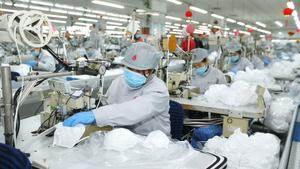 Workers make face masks in the workshop of a textile company in Jimo District of Qingdao, East China's Shandong province, China, Feb 12, 2020. (PHTOO / XINHUA)
Workers make face masks in the workshop of a textile company in Jimo District of Qingdao, East China's Shandong province, China, Feb 12, 2020. (PHTOO / XINHUA)
Chinese scientists and companies have created innovative ways, including developing reusable face masks and sanitizing used masks at home, to cut mask demand for home or factory use, allowing nonmedical personnel to be safe from the novel coronavirus and return to work without worrying about mask supply.
Last month, companies in Guangdong province, Beijing and Shanghai reported producing a new type of face mask that uses a nanomaterial membrane, rather than the typical melt-blown fabric, to filter bacteria, viruses and other pathogens, according to local health and medical products authorities.
The new masks are on par with N95 standards, meaning they filter particles of all sizes with at least 95 percent efficiency.
The masks are also comfortable, easy to breathe through and can be reused up to 20 times depending on the user's setting and wear time, the authorities said
The masks are also comfortable, easy to breathe through and can be reused up to 20 times depending on the user's setting and wear time, the authorities said.
The retail price for the masks created by companies from Shanghai will be around 15 to 20 yuan (US$2.14 to US$2.85) each.
READ MORE: Drastic measures needed to address face-mask shortage
The prices for the ones made by Beijing and Guangdong companies are still unknown because those companies just recently began production.
On Feb 21, Premier Li Keqiang said during an inspection of one of the mask makers in Beijing that China would need to boost efforts to push face mask production to over 100 million a day to meet national demand.
Li said face mask supply is a basic prerequisite for resuming work and production and serves as a key medical and psychological barrier that protects the public.
Li urged the National Medical Products Administration to speed up appraisal of nanofiber membrane masks so factories could scale up production once approval is granted.
By Feb 25, China was capable of producing about 54 million face masks a day, including over 900,000 medical N95 face masks, Ou Xiaoli, director of the National Development and Reform Commission's Department of Social Development, said in a news briefing.
The daily mask output was almost three times higher than that at the end of the Spring Festival holiday in late January.
"Production capability has been expanded to 110 percent of the normal level," Ou said, adding that the supply of masks can meet front-line health workers' needs.
ALSO READ: Mask shortage highlights the altruism of Shenzhen
However, Ou noted that as work and production resume across the nation, nonmedical personnel's demand for masks has soared.
"It is high time that we use our face masks scientifically and cut down on waste," he said.
"It is unnecessary for those who only meet one or two people a day to change their masks once every four hours. There is no need to wear a mask in open, uncrowded and well-ventilated areas. We also advise people to extend the wear time and usage of their normal masks based on their circumstances."
While experts and guidelines have strongly discouraged frontline medical staff and others with high risk of infection from reusing their masks, ordinary people can sanitize their masks at home and reuse them so long as the mask is not damaged or stained.
One method developed by scientists from Beijing University of Chemical Technology advises people to soak used medical masks in water at around 56 C or slightly higher for 30 minutes.
They should then pull the mask out and remove surface moisture, then place the mask on a paper towel or any other insulating surface and dry the remaining water with a hair dryer for about 10 to 15 minutes.
Wang Dan, a chemical engineer from the university, said the procedure aimed to infuse the filter with electrostatic charge, a key contributor to a mask's high levels of filtration that gradually loses efficacy after use.
Wang said the recharged mask's filtering efficiency was on par with new masks.
However, he stressed that the method was only for ordinary people who had no access to new masks and were at low risk of infection.


